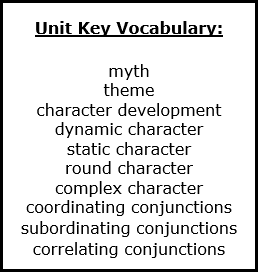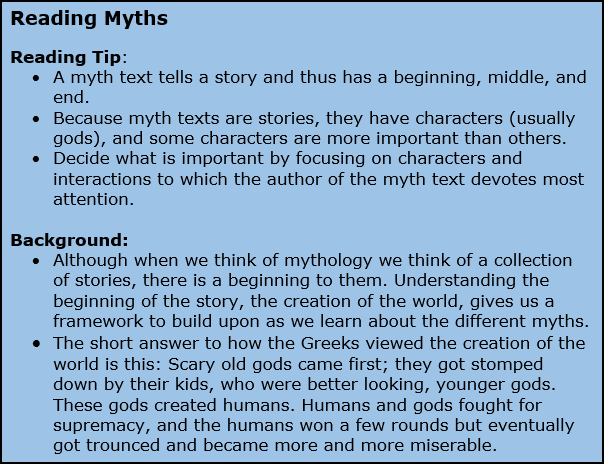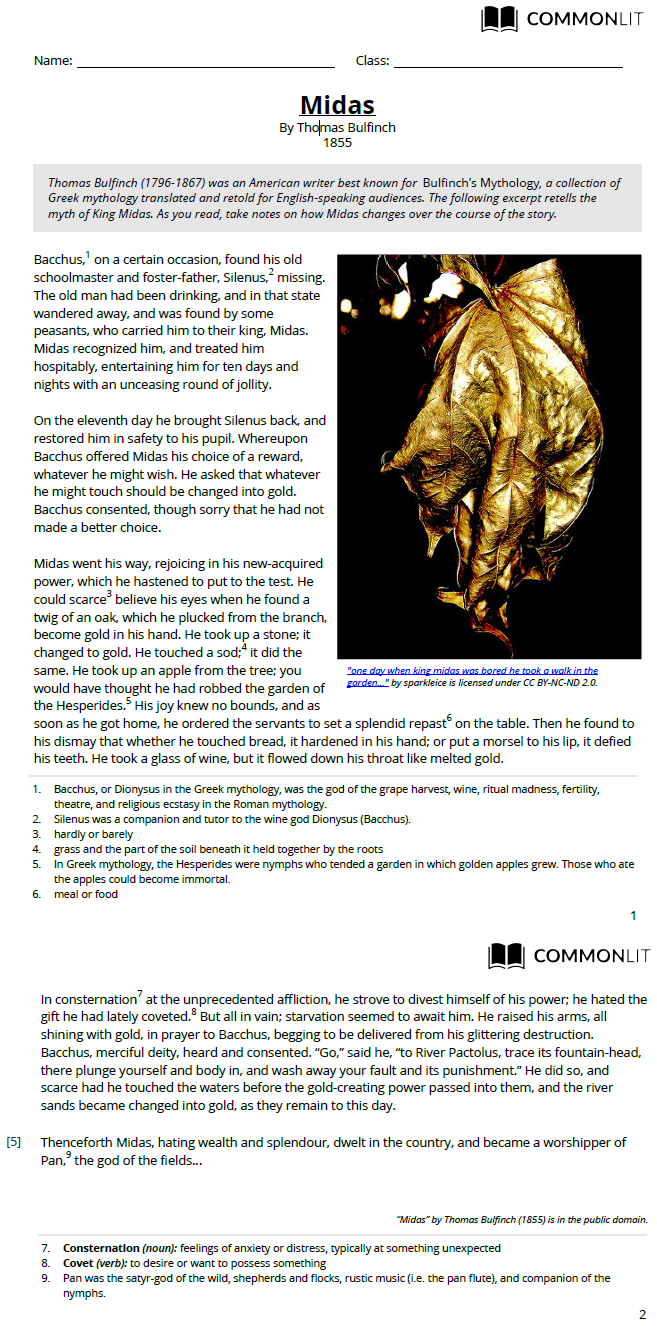
READING LITERATURE: MYTH
 |
Overview
In this unit, you will learn about myths and the related questions that might appear on the AIR Assessment. At the end of the unit, you will review conjunctions. Above, you will find a list of key vocabulary for this unit.
*Download the attached pdf to take notes during the lesson. 
A Myth is a traditional story, especially concerning the early history of a people or explaining some natural or social phenomenon, typically involving supernatural beings or events.
Myth usually features ruling gods, goddesses, deities, and heroes having god-like-qualities, but status lower than gods.
Myths exist in every society, as they are basic elements of human culture. The main function of myths is to teach moral lessons and explain historical events.
For more information on the Greek Gods that often occur in myths, click on the link below.
 |
 |
STOP! Complete Questions 1 through 3 in the questions section.
Character Development
All stories must have certain characteristics or elements. Without these elements, any piece of literature would cease to make sense or serve a purpose. For example, stories must have a plot or events that take place. Another essential story element is the character. Character can be defined as any person, animal, or figure represented in a literary work. There are many types of characters that exist in literature, each with its own development and function.
Nearly every story has at least one protagonist. A protagonist is a main character who generates the action of a story and engages the reader's interest and empathy. The opposite of the protagonist is the antagonist. An antagonist is a character who opposes the protagonist.
The concept of dynamic and static characters is closely tied to character development. A dynamic character is one who goes through some sort of change; they show character development. Static characters, on the other hand, are those who do not change throughout the course of the story. They serve to show contrast to dynamic ones, refusing to grow and remaining in one place or mentality.
Round characters are fully-developed figures in the story. They are more realistic and complex and show a true depth of personality. They require more attention by the reader; they can make surprise decisions or puzzling ones.
A work of literature often centers on a complex character- a character who is dynamic and round. It important for the reader to analyze how complex characters develop over the course of a text, interact with other characters, and advance the plot or develop the theme.
STOP! Complete Questions 4 through 6 in the questions section.
The rest of this unit will be based on the myth Midas. Read the myth carefully and then look at the questions about the text below.
PASSAGE 1
 Midas PDF |
Answering the Questions: Tips & Tricks
A theme is a main idea or an underlying meaning of a literary work.
Remember from the previous unit that, in fiction writing, the central idea is the theme. To determine the theme, the reader must look at the whole passage. Use the theme litmus test to answer any questions about theme.
A synonym is a word or phrase that means exactly or nearly the same as another word or phrase. Context clues are hints that an author gives to help define a difficult or unusual word. The clue may appear within the same sentence as the word to which it refers, or it may appear somewhere else in the passage.
REMEMBER: It important for the reader to analyze how complex characters develop over the course of a text, interact with other characters, and advance the plot or develop the theme.
STOP! Complete Questions 7 through 11 in the questions section.
Grammar Review 7: CONJUNCTIONS
A conjunction joins words or groups of words in a sentence. There are three types of conjunctions:
1. Coordinating Conjunctions
Connect words, phrases, or clauses that are independent or equal
for, and, not, but, or, yet, and so (FANBOYS)
2. Correlative Conjunctions
Used in pairs
both/and, either/or, neither/nor, not only/but also
3. Subordinating Conjunctions
Used at the beginning of subordinate clauses
although, after, as, as long as, before, because, how, if, once, since, so that, than, though, until, unless, when, while, where, whether, whenever, etc.
Click on the following link to watch a video further explaining conjunctions.
 |
Let's Practice!
1. Highlight each conjunction. Identify the type of conjunction (coordinating, correlating, or subordinating).
|
2. Highlight each conjunction. Identify the type of conjunction (coordinating, correlating, or subordinating).
|
3. Highlight each conjunction. Identify the type of conjunction (coordinating, correlating, or subordinating).
|
STOP! Complete Questions 12 through 15 in the questions section.
 |